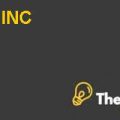Samsung & Apple Case Study Solution
Apple Inc. Overview
Apple Computers Inc. was founded in 1976, by Steve Jobs & Steve Wozniak, with a vision to change the world’s perception about computers. The company introduced innovative products and quickly became a top name in the computer industry with their revolutionary product iMac. To enter the consumer electronics industry; the company’s name was changed to Apple Inc. in 2007. With the introduction of iPhone in 2007, the company started gaining popularity in the mobile industry, and through its continual improvement became the market leader of the industry, and got recently took over by its closest competitor Samsung. Annual revenue for the year was $ 265.6 billion. After, the death of the CEO Steve Jobs, and recent negative publicity the company needs some structural changes to rise to the top again.
Customer Profile
Apple Inc. has a wide range of products and services, for this analysis only electronic gadgets will be taken into consideration.
The key value proposition of Apple Inc. is superior quality and advanced functionality of its products. Apple products are renowned for their quality, speed, and are considered as a symbol of achievement by people.
Apple Target Segment
- Geographical target segment of Apple Inc. are the people in the urban regions of the US, and all over the world.
- Demographically Apple targets both males & females between the ages 20-45, who have high purchasing power. Professionals such as executives, managers, students and children of high earning families.
- They have created customer loyalty by delivering quality and advanced features at a premium price.
- Middle and upper classes people who want a sense of belonging and achievement.
Positioning
- Apple Inc. positions its products as a premium brand for a particular segment that appreciates the innovative quality, design, features, speedy performance, and additional services over the price of the products.
- People feel a sense of achievement by using the apple products, and the first thing that comes in their mind when you ask them about Apple is quality.
Innovative product features provide a convenience to the customers, with students using it for their educational purposes, which makes their life simpler to manage notes and documents, executives prefer the products because of their reliability and speed, which help them to complete their work in less time than other available alternatives.
Company Strategy
- Apple Inc. follows the product differentiation strategy, and focuses on the unique and distinctive key features to differentiate itself from the competitors. So, that its customers willingly accept to pay extra for the quality of the products.
- The company’s majority of the human capital population is comprised of engineers, who are responsible for the product design, and are remunerated handsomely. Idea generation and quality enhancement are appreciated at all levels.
- Apple is looking to penetrate the emerging economies, especially the Asian ones, where its market share is low. These markets present tremendous potential for growth and development as the Apple Inc. product reach is limited in these markets.
- Market development growth strategy is followed in Apple Inc. where they look for new opportunities to create a market for their products or the possibilities of entering an entirely new business.
Financial Profile
Apple Inc. posted $ 265.6 billion in revenue in the current year, and is penetrating Asian markets to capture more market share and regain its position as the leader of the industry.
| Last 5 years average (Mar 2019) | ||
| Ratio | Apple | Industry |
| Operating Margin | 28.04% | 19.08% |
| ROE | 40.75% | 29.44% |
| ROA | 16.47% | 17.19% |
| Source: Investing.com | ||
Apple Inc. operating margin average over the last 5 years is well above the average, as expected from a recently dethrone market leader. The main reason is the premium they charge on their products, as other competitors are more cost efficient in the production process. Recent Tax relaxations in the US, higher margins on premium products and use of debt to gain tax leverage are the key reasons behind Apple Inc. ROE of 40.75%, which is almost double in percentage than its nearest rival. Whereas, it’s Return on Assets average is slightly lower than the industry,but still a healthy and positive one, which forecasts further growth in revenues.
Operating Model
- For its inbound logistics, Apple Inc. has built strong alliances with their international suppliers to maintain a quality standard of the raw materials. Majority of whom are Asian based, apart from Foxconn and 3M. Due to its high bargaining power, Apple Inc. has maintained its quality standards, and through procurement efficiency it has added a value to the process.
- Apple has successfully reduced its cost of production by shifting its operations to the countries where the labor costs are cheaper. China does majority of the manufacturing of Apple products. Some other countries from Asian, European and African countries are also responsible for manufacturing at a smaller scale. By cutting higher labor cost in the US, Apple has gained a significant competitive advantage in the industry.
- Warehousing and distribution of finished products are the major part of its outbound logistics network, and by using the E-commerce platform Apple has reduced the costs of distribution handsomely.
- For marketing its new and highly anticipated products, Apple uses all sorts of channels (print, digital & online) through creative advertising to engage its customers. The uniquely targeted campaigns have further built the brand loyalty among its customers.
- For delivering exceptional after sales service, Apple Inc. has built experience centers all around the world. The personnel at these centers are soft spoken and well trained to resolve the issues of customers appropriately in a timely manner, as well as describe the products’ qualities to the new potential customers.
Company Conclusions
Apple is the second most valuable brand in the world, with a brand value of $ 146.3 billion. It uses a differentiation strategy by offering higher quality, design, high performance products and services at a premium price to certain target market. Apple has fallen behind Samsung in the smartphone industry, and needs to continuously innovate by bringing new features in the products, which are currently not available in the market. It should penetrate in the Asian emerging markets specially China, where most of its electronic gadgets are made, and India, where it plans to setup more production facilities due to the availability of cheap labor.............
This is just a sample partical work. Please place the order on the website to get your own originally done case solution.













